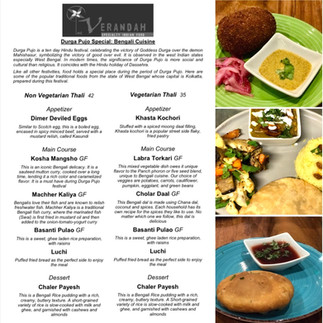Bengali Cuisine: Durga Pujo Bhog and Mustard oil
- Radhika Sule

- Nov 12, 2021
- 3 min read
I am not sure why it had taken me until 2017 to visit Kolkata for the first time. My first impression of the city was its speed, or rather the lack of it. Even the clock seemed to be move sluggishly. The leisurely pace of life offered a perfect setting to enjoy its cuisine. My friend who was travelling with me was a die hard foodie herself and came prepared with a list of must haves. So off we set…
Our first meal was a continental breakfast at the Calcutta Club, where we stayed. We had omelets and chicken sandwiches with fresh juice, reflecting the culture of the Bengali Babus, who were trying the assimilate into the British style of living.
In spite of this big breakfast, we went searching for authentic Bengali food for lunch. We were led to a prominent local restaurant chain called Bhojohari Manna. Its décor was rather nondescript, but the aromas were sensational. She ordered and I dutifully complied by inhaling the food as soon as it was brought to us. There was fish fry, fish head curry, mutton, rice, Luchi… and in a little side plate was a grainy yellow dip called Kasundi. It resembled Dijon mustard, which seemed rather misplaced at first, but fell perfectly in place with the rest of the dishes. All my senses were exploding at the same time! I couldn’t tell what it was but I couldn’t stop eating.
In evening, we opted for street food and were led to Nizam’s Kathi rolls; which captured the essence of Mughlai influence on the food. They were everything they promised: delicious, succulent meat wrapped in a soft yet crisp roti. It was finger licking good, without the need to actually do so.
The following day, a leisurely boat ride on the Hooghly river led to more street side snacking. We had the renowned Jhaal Moori (puffed rice with onions, spices, peanuts, chutneys) and Puchka (hollow crisp pooris filled with tangy spiced water and potatoes). Yet again, I experienced the same exploding of senses I had the previous day. Still unable to decipher what it was that was blowing me away, I keenly observed the vendor. While he assembled the jhal moori, I recognized all ingredients but a dark yellow liquid he squirted in. What was it? I had to know. So I asked. And just like that, I was introduced to one of the biggest revelations I’ve had in my food journey: Mustard Oil.
Growing up in a Maharashtrian family, all I knew was a rather neutral peanut oil and homemade ghee as cooking fats. In fact we scorned at the mustard oil, calling it “smelly”. And up until this past year, I had no reason to cook with mustard oil. But after cooking Kashmiri and then Punjabi cuisines, I had learnt to fearlessly use this strong, pungent oil liberally in the Verandah kitchen.
With this, as I embarked upon cooking a Bengali feast on the occasion of Durga Pujo, I reached out to Molee Chakraborty, a Bengali friend who was once a neighbor. Even though she had moved away, she has always been a cheerleader for my food adventures. Long back, she had cooked a delectable meal for us, the memory of which still lingers on my palate. Molee drew up a menu, offered tips and tricks and saw me through the cooking process.
As for me, each cuisine teaches me something new. I made a batch of Gorom Moshla and Panch Phoron spice blend. I had my reservations with regards to the copious amount of sugar in savory dishes. But eventually it all came together in perfect harmony. And to my surprise, in my local grocery store, along with mustard sauces from all around, I found a bottle of Kasundi!










Comments